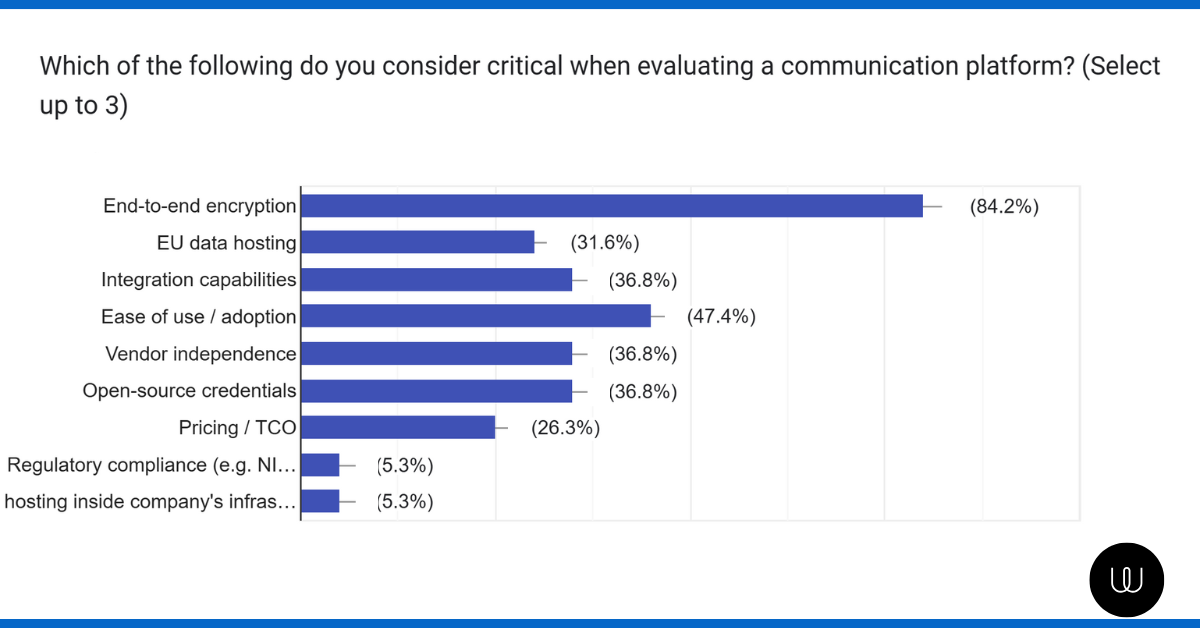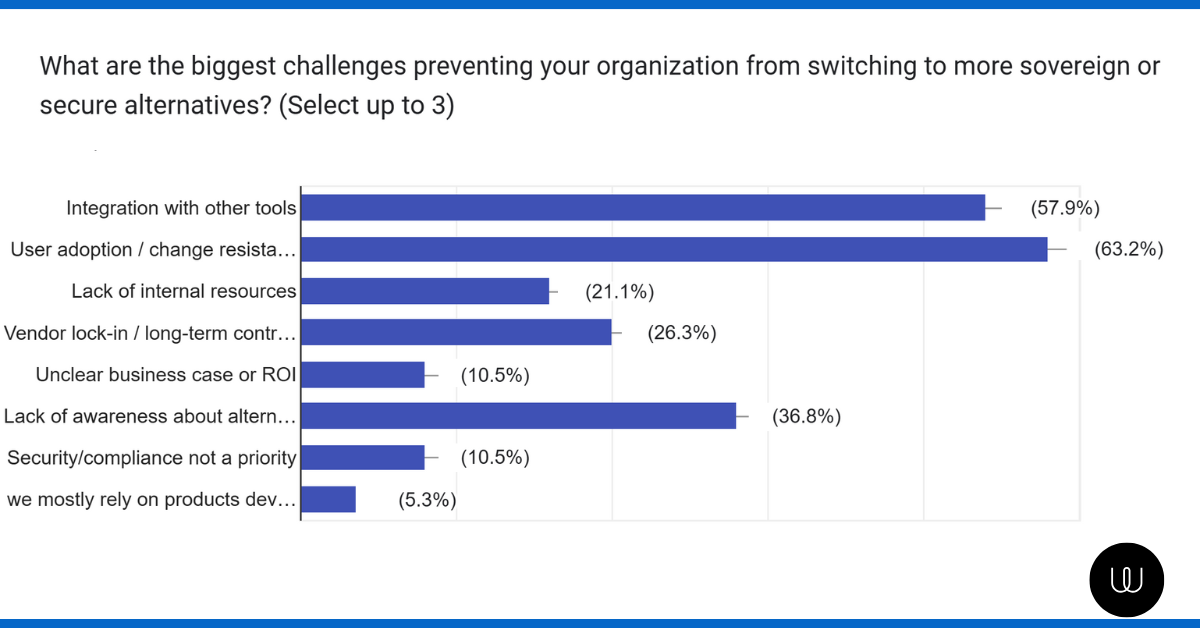European organizations want to adopt sovereign digital tools. Tools built in the EU, aligned with data protection regulations, and designed for transparency. But the reality is more complex.
Our recent EU Sovereignty survey of 273 decision-makers across IT, compliance, and public sector roles shows a clear paradox:
- Encryption, open source, and EU data hosting are top priorities
- But Microsoft Teams, Zoom, and Slack remain the most used tools
- The blockers? User resistance, integration friction, vendor lock-in, and lack of awareness
This article explores why intent isn't translating into action and what’s needed to close the sovereignty gap.
What Organizations Say They Value
When asked to rank key criteria for evaluating communication platforms, respondents were clear:
- 84.2% prioritize end-to-end encryption
- 47.4% highlight ease of use
- 36.8% name EU data hosting and open-source credentials as critical

These preferences align with the foundational principles of digital sovereignty: data protection, transparency, and autonomy.
But the actual tools in use tell a different story. Despite the strong alignment around security and sovereignty, most respondents still rely on U.S.-based platforms. Teams, Zoom, and Slack are widely used, even though they fall short on core criteria like jurisdictional control and verifiable encryption.
This disconnect isn’t about a lack of concern. It reflects real, persistent barriers that stop organizations from switching.
The Four Key Challenges Holding Back Sovereignty
1. User Adoption and Change Resistance (63.2%)
Comfort, routine, and inertia are among the most underestimated forces in digital transformation. Even when CISOs or data protection officers flag urgent compliance risks, the perception among everyday users is often: “Why fix what isn’t broken?”
In practice, new tools face skepticism not because of their security credentials, but because of change fatigue and perceived complexity. This resistance is especially acute in large organizations where workflows are deeply embedded and new tools are viewed as productivity disruptors. For frontline workers or non-technical staff, even a minor shift in UX can create friction.
Moreover, modern platforms like Teams and Slack have normalized a culture of convenience over caution. Features like persistent presence, emoji reactions, or threaded chats become daily habits and any change, no matter how secure or sovereign, must compete against that comfort. Without extensive onboarding, change management, and internal champions, even the most compelling tools will struggle to reach critical mass.
2. Integration with Existing Systems (57.9%)
Digital ecosystems are complex webs, not isolated apps. Tools like Teams and Zoom are deeply integrated into the enterprise stack: Outlook calendars, Active Directory, SharePoint, Jira, and even HR systems. Replacing one component often triggers a cascade of compatibility challenges.
This integration depth gives incumbents a major advantage. Microsoft’s strength, for instance, lies not just in Teams, but in how Teams knows your calendar, auto-authenticates across apps, and embeds directly into existing workflows. For many EU-native tools, replicating this seamlessness is a work in progress.
What begins as a technical hurdle often turns into political risk. Organizations avoid risk, and perceived fragility in integrations can halt promising alternatives before they’re even tested. Sovereign platforms must prove that they don’t just exist, they coexist, without adding friction to daily operations.

3. Lack of Awareness About Alternatives (36.8%)
Visibility is power. And EU-native tools, no matter how innovative or secure, still struggle with discoverability. In many cases, decision-makers default to U.S. platforms not because they’re better but because they’re known. Brand recognition, market presence, and aggressive enterprise sales create a gravitational pull that’s hard to resist.
Meanwhile, sovereign tools like Internxt or Tuta often operate with limited marketing budgets, fragmented ecosystems, and minimal media coverage. Even well-established platforms that meet all the right compliance and encryption criteria get dismissed as “niche” or “not enterprise-ready.”
This creates a vicious cycle:
- Low awareness leads to low adoption
- Low adoption means fewer references or success stories
- And fewer references mean less credibility in procurement processes
Until EU-based alternatives become default options, not obscure ones, the sovereignty gap will persist, not due to product flaws but visibility voids.
4. Vendor Lock-In and Long-Term Contracts (26.3%)
Even the most motivated organizations often find themselves trapped. The mechanics of vendor lock-in are subtle but powerful:
- Multi-year enterprise contracts with steep early termination penalties
- Data trapped in proprietary formats that require complex, costly migrations
- Internal tools and workflows customized around a vendor’s APIs or SSO mechanisms
Switching doesn’t just involve a financial cost, it risks operational continuity. That’s especially daunting in critical sectors like public administration, healthcare, or utilities, where downtime or disruption has real-world consequences.
“It’s not about willingness. It’s about feasibility. We’d switch, but we can’t afford to break what’s working today,” one IT lead shared.
True sovereignty requires not just better tools, but better exit paths: procurement standards that favor portability, funding for migration support, and regulatory pressure on incumbents to open up interoperability.
-1.png?width=1200&height=628&name=EU%20sovereignty%20report%20(1)-1.png)
Closing the Gap Between Strategy and Execution
Most respondents in our survey share a common intent: reduce reliance on foreign vendors and adopt tools that reflect EU values and regulatory frameworks. But strong intent doesn’t equal successful adoption.
To accelerate progress on sovereignty, organizations need more than policy signals. They need:
- Clear, supported paths to migrate away from dominant platforms
Wire offers seamless, productive collaboration in an all-in-one workspace. From secure messaging and conferencing to file sharing and guest access, Wire helps teams transition without sacrificing usability or compliance.
- Integration-ready alternatives with strong UX and API compatibility
With the new Wire SDK and upcoming Integrations Marketplace, teams can build and deploy custom apps, streamline workflows, and enhance secure communication, all while staying within Wire’s end-to-end encrypted ecosystem.
- Procurement support and visibility for European-built solutions
Wire is actively increasing awareness through initiatives like Wire Uncut and ongoing thought leadership, amplifying the visibility of European innovation in secure collaboration.
- End-user onboarding resources to reduce resistance
Wire’s product-led growth approach lets organizations try the platform for free, scale gradually, and onboard users at their own pace, reducing friction and accelerating adoption.
The Takeaway:
The issue isn’t a lack of will, it’s a lack of practical support to turn values into action. If Europe truly wants to close the sovereignty gap, it must do more than regulate. It must invest in visibility, integration, and switching infrastructure to make sovereignty feasible, not just aspirational.
